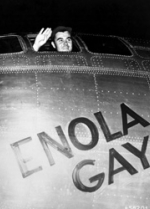Crew of the Enola Gay

Fifty years after the crew of the Enola Gay dropped the atomic bomb on Hiroshima, hastening Japan's surrender, The American Legion honored Tibbets and his crew with the Distinguished Service Medal.
"There is no doubt in my mind that many of you who are here today would not be here if it hadn't been for the courageous mission of the men of the Enola Gay," National Commander William Detweiler told convention delegates.
As Enola Gay's pilot, Tibbets said Pearl Harbor was the animating force for his mission. "That unprovoked attack united this nation as nothing had before and nothing has since," he told Legionnaires. "A single determination prevailed, which was, ‘You can't get away with that, and we will show you.'" He praised Americans for pulling together, both on the battlefield and in the factories at home to support the war effort.
Navigator Theodore "Dutch" Van Kirk, bombardier Thomas Ferebee and radio operator Richard H. "Dick" Nelson joined Tibbets on stage. Tail gunner George R. "Bob" Caron had died several months earlier, at 75.

Tibbets named the B-29 bomber Enola Gay, for his mother. On Aug. 6, 1945, it was one of seven B-29s that took off under cover of night. The small group included a standby, a photo plane and one with scientific instruments. In the early-morning hours, the cloud cover was minimal over Hiroshima, the primary target. Enola Gay dropped the first atomic bomb, "Little Boy," was dropped at 8:15 a.m.
Three days later,pilot Charles W. Sweeney and his Bock's Car crew dropped the second atomic bomb, "Fat Man," on Nagasaki.
Tibbets retired from the Air Force in 1966 and died in 2007, at 92. Ferebee died in 2000, at 81. Nelson died in 2003, at 77.
Van Kirk is the last surviving member of the crew.
For more on the Enola Gay, click here (http://www.answers.com/topic/enola-gay).
